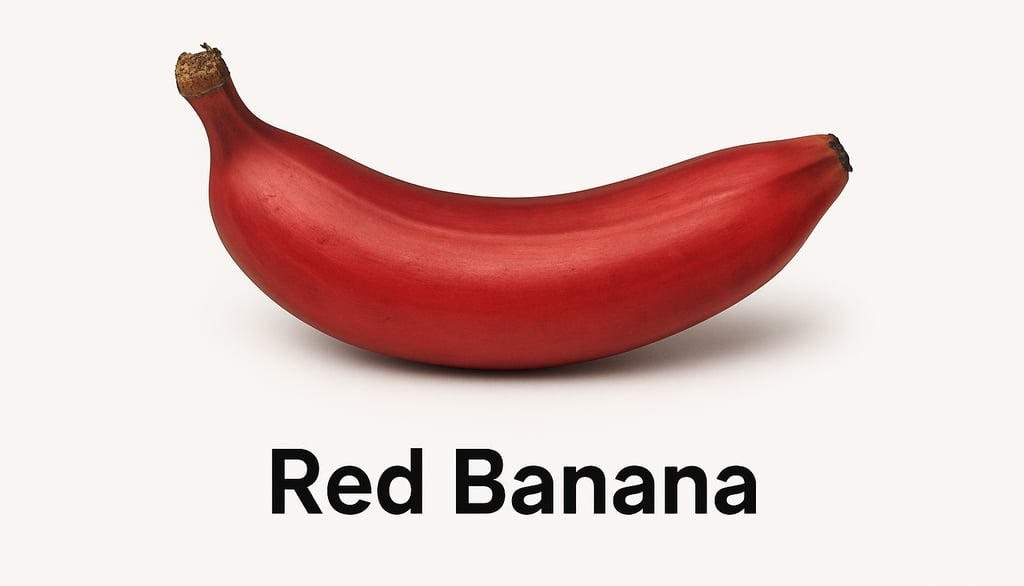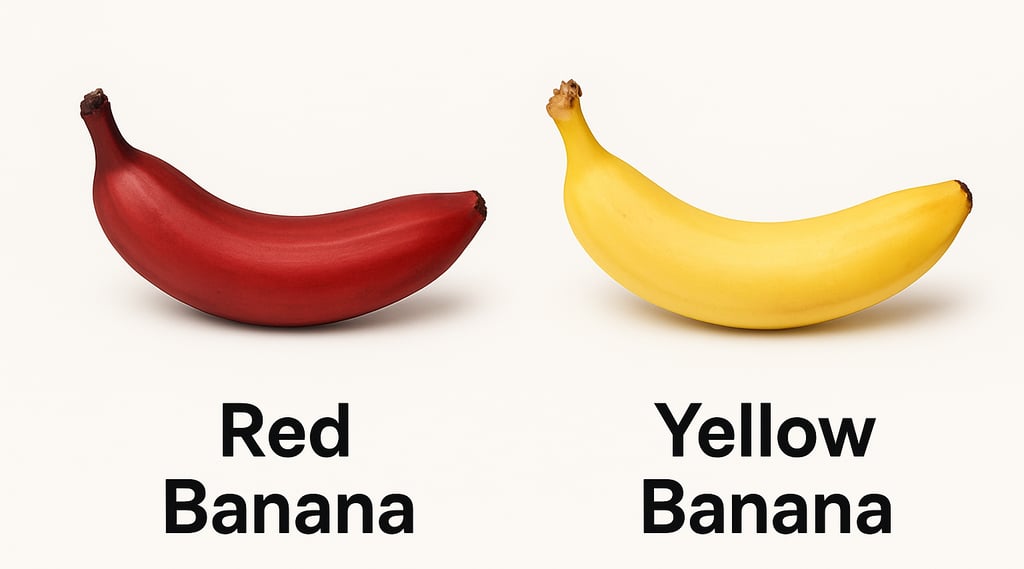“Red Banana : Taste, Nutrition, and Health Benefits”
Red bananas, a striking variant of the more commonly known yellow bananas, are recognized for their distinct reddish-purple skin and subtly sweet flavor.
EVERYTHING ABOUT FRUITS
8/29/20258 min read


What are Red Bananas?
Red bananas, a striking variant of the more commonly known yellow bananas, are recognized for their distinct reddish-purple skin and subtly sweet flavor. These unique fruits are primarily cultivated in regions that provide a warm and humid climate, such as Southeast Asia, East Africa, and parts of Central America. Unlike their yellow counterparts, which are widely popular in global markets, red bananas are less commonly found, offering a distinctive taste and culinary experience.
The most notable physical characteristic of red bananas is their skin, which adopts a deep red to purple hue as it ripens. When peeled, the flesh is creamy and has a yellowish tint, often described as sweeter and richer than that of yellow bananas. This difference in taste can be attributed to their higher sugar content, making red bananas an excellent choice for desserts or smoothies. In addition to their pleasing flavor profile, red bananas are particularly favored for their nutritional benefits.
From a nutritional standpoint, red bananas offer an impressive array of vitamins and minerals, providing a healthy alternative to many processed snacks. They are rich in potassium, essential for heart health and muscle function, and also contain vitamin C, which contributes to a robust immune system. Comparative analyses show that red bananas are higher in certain antioxidants compared to yellow bananas, enhancing their appeal as a superfood. Below is a table summarizing the nutritional differences between red bananas and yellow bananas:
Nutrient Red Bananas (per 100g) Yellow Bananas (per 100g)
Calories 90 89
Protein 1.1g 1.1g
Fiber 2.1g 2.3g
Vitamin C 8.7mg 8.7mg
Potassium 358mg 358mg
In summary, red bananas are not only visually captivating but also offer a unique nutritional profile and flavor that sets them apart from the traditional yellow varieties. Their distinctive qualities make them a worthwhile addition to the diet of health-conscious individuals seeking variety and enhanced taste in their fruit selections.
Culinary Uses of Red Bananas
Red bananas, with their vibrant hue and distinct sweetness, offer a variety of culinary applications that extend beyond mere snacking. Their flavor profile is often described as a fusion of raspberry and mango, making them particularly versatile in both sweet and savory dishes. One of the simplest yet delightful ways to incorporate red bananas into your diet is through smoothies. Combining red bananas with yogurt, spinach, and a splash of almond milk creates a nutritious and refreshing drink, rich in vitamins and minerals.
In the realm of desserts, red bananas can be utilized in several delightful recipes. Baking a banana bread using red bananas not only enhances the flavor but also adds a unique color to the traditional treat. Additionally, red bananas can be sliced and used as a topping for pancakes or waffles, providing a sweet contrast to nut butters or syrups. For a more sophisticated dessert, red bananas can be poached in syrup and served over creamy vanilla ice cream.
On the savory side, red bananas can make an interesting addition to salads, where their sweetness balances the bitterness of greens. A simple salad featuring mixed greens, sliced red bananas, walnuts, and a light vinaigrette can serve as a refreshing side dish. Additionally, red bananas can be used in curries or stir-fries, where their texture holds up beautifully while they absorb surrounding flavors. When exploring pairings, consider using red bananas with flavors such as coconut, lime, and spices like ginger or cinnamon, which can elevate both flavor and presentation.
Overall, red bananas are an underappreciated ingredient that can enhance a wide array of dishes. Exploring their culinary uses not only diversifies your meals but also brings a unique sweetness that is distinct from their yellow counterparts. With the right recipes and pairings, red bananas can certainly become a staple in your culinary repertoire.
Health Benefits of Red Bananas
Red bananas, an intriguing variant of the common yellow banana, are renowned for their distinct nutritional profile and myriad health benefits. Rich in essential vitamins and minerals, these fruits offer a wide range of advantages that contribute to an individual's overall wellbeing. Regarded as a good source of vitamin C, red bananas bolster the immune system and support skin health by promoting collagen production. Furthermore, they contain vitamin B6, which plays a significant role in brain development and function. This vitamin also aids in the synthesis of neurotransmitters that regulate mood, highlighting the potential of red bananas to enhance mental health.
In addition to vitamins, red bananas are packed with dietary fiber, which is crucial for digestive health. Consuming fiber-rich foods, like red bananas, can help prevent constipation and promote regular bowel movements. Moreover, the fiber content can help control blood sugar levels by slowing the absorption of carbohydrates, making red bananas an excellent choice for those managing blood sugar. Rich in potassium, these bananas help in maintaining healthy blood pressure levels, promoting cardiovascular health by preventing the risk of hypertension.
Antioxidants in red bananas, such as anthocyanins, contribute significantly to their health benefits. These compounds help combat oxidative stress and inflammation in the body, reducing the risk of chronic diseases. A comparison of red bananas and yellow bananas reveals that while both are nutritious, red bananas offer higher levels of certain antioxidants and vitamins, making them slightly more beneficial in some respects.
However, as with any food, moderation is key. Some individuals may experience digestive disturbances if consuming excessive amounts of bananas. It is also vital to consider any allergies or reactions. In conclusion, incorporating red bananas into a balanced diet can provide a wealth of health benefits, enhancing overall health and wellbeing.
Cultivation and Growing Red Bananas
Red bananas (Musa acuminata), known for their sweet flavor and distinct reddish-purple hue, thrive in specific climates and soil conditions. Ideally, red banana plants flourish in subtropical to tropical regions, where temperatures range between 75°F to 95°F (24°C to 35°C). Ensuring a frost-free environment is crucial for successful growth, as even brief exposure to cold temperatures can adversely affect the plants. They require ample sunlight, ideally receiving five to twelve hours of direct sunlight per day.
Soil quality significantly impacts the cultivation of red bananas. These plants prefer well-draining, loamy soil enriched with organic matter. Maintaining a pH level between 5.5 and 7.0 optimizes nutrient absorption, facilitating robust growth. Home gardeners can enhance soil conditions by incorporating compost or well-rotted manure into the planting area, which improves moisture retention and provides essential nutrients.
Proper care and maintenance are vital for nurturing red banana plants. Regular watering is essential, especially during dry periods, as bananas require consistent moisture to develop fruit. However, it is equally important to prevent waterlogging, which can lead to root rot. Mulching around the base of the plants helps retain soil moisture and suppresses weed growth.
When growing red bananas, gardeners should be aware of potential challenges. Common pests include aphids, spider mites, and banana weevils, which can negatively impact the health of the plant. Implementing integrated pest management practices, such as introducing beneficial insects or using organic pesticides, can mitigate these issues. As the plants mature, they typically take about 9 to 12 months to bear fruit. Harvesting should occur when the bananas have turned fully red, indicating ripeness. Proper harvesting methods, including cutting the fruit cluster with a sharp knife, ensure minimal damage to the plant, promoting future growth. By following these guidelines, home gardeners can successfully cultivate red bananas and enjoy their unique taste.
Where to Buy Red Bananas
Finding red bananas can be an intriguing venture, as these exotic fruits are not as commonly available as their yellow counterparts. When searching for red bananas, consumers have several options, including physical stores and online platforms.
Local grocery stores or specialty markets that focus on organic or exotic produce are often good places to start. Retailers such as Whole Foods, Trader Joe's, and select farmers' markets may occasionally stock red bananas. When visiting these locations, it is advisable to examine the physical condition of the bananas. Look for firm fruit with a vibrant reddish hue and minimal blemishes, as these indications often reflect freshness. Local ethnic grocery stores, especially those catering to Asian and Caribbean communities, can also offer red bananas, so it may be worth checking these establishments.
If physical trips fall short, online shopping provides a convenient alternative. Websites like Amazon can offer red bananas through various sellers, though availability may vary greatly based on location and season. Specialty online retailers, such as Melissa's Produce and Tropical Fruit Box, frequently stock red bananas and assure timely delivery, often providing information on ripeness and storage recommendations. A good practice when ordering online is to read customer reviews regarding delivery quality and freshness.
To enhance your shopping experience, a comparison of prices at several stores can be beneficial. Consider creating a simple table that reflects the price per pound, availability, and delivery options at both local retailers and online services. Ultimately, ensuring the freshest red bananas is achievable through careful selection, whether in-store or online, while also being conscious of seasonal disparities in availability.
Red Bananas vs. Other Exotic Fruits
Red bananas, with their distinct ruby skin and creamy flesh, not only stand out for their appearance but also offer unique culinary and nutritional values that set them apart from other exotic fruits. When compared to fruits like purple mangosteen, jackfruit, and dragon fruit, red bananas exhibit notable similarities and differences in taste, texture, and versatility.
In terms of flavor, red bananas are sweeter and softer than their yellow counterparts, boasting a hint of raspberry or strawberry notes. This differs from the mangosteen, which is often dubbed the "queen of fruits" due to its sweet and tangy flavor profile that is unlike any other fruit. Meanwhile, jackfruit has a unique and complex taste, often described as a mix of banana and pineapple, and is primarily known for its fibrous texture. Dragon fruit, with its mildly sweet flavor and vibrant appearance, offers a refreshing contrast to both bananas and jackfruit.
Nutritionally, red bananas are rich in essential nutrients, providing a good amount of potassium, vitamin C, and dietary fiber, similar to the beneficial profiles of other exotic fruits. Mangosteen is high in antioxidants, jackfruit is notable for its low-calorie content and substantial fiber, and dragon fruit is praised for its high vitamin C and healthy fat content. Each of these fruits brings unique health benefits to the table, encouraging consumers to diversify their diets.
When it comes to culinary uses, red bananas can be enjoyed in various ways; they can be eaten raw, baked, or blended into smoothies, offering an array of options. In contrast, jackfruit is often used as a meat substitute in vegan dishes due to its texture, while mangosteen is typically consumed fresh for its juicy sweetness. Dragon fruit is commonly featured in salads or desserts because of its striking appearance and subtle flavor. The variety in applications showcases how these exotic fruits, including red bananas, each have a place in a well-rounded diet.
Fun Facts about Red Bananas
Red bananas, a lesser-known variety of bananas, are not only visually distinctive but also come with a plethora of intriguing facts that can enhance one’s appreciation for this unique fruit. One notable characteristic is their striking reddish-purple skin, which differentiates them from their common yellow counterparts. This unique coloration is due to higher levels of anthocyanins, a type of antioxidant that contributes both to their color and potential health benefits.
Historically, red bananas are believed to have originated in Southeast Asia and have been cultivated for over a thousand years. They were primarily grown in regions like India, where they are often referred to as "red dacca" bananas. Their popularity has spread worldwide, particularly in tropical regions, making them a delightful part of diverse culinary traditions. Interestingly, red bananas are sweeter than regular bananas, with a more pronounced berry-like flavor, making them an attractive option for those looking to enjoy a more flavorful fruit.
A unique fact about red bananas is their versatility in cooking and baking. They can be used in the same manner as yellow bananas, adding a colorful twist to smoothies, desserts, and savory dishes. Their lower starch content contributes to a creamier texture, which can enhance recipes. Nutritionally, red bananas are also noteworthy; they are rich in potassium and vitamin C, contributing to overall health and wellness.
Moreover, red bananas have a shorter shelf life compared to traditional varieties, making them a special treat. They are often enjoyed fresh but can also be found in various dried or processed forms. To summarize, red bananas are truly a fruit worth exploring, offering both flavor and nutrition, along with a fascinating history that highlights their significance across cultures.


"Boosting Crop Growth With Nature's Power"
Contact Us:
E Mail: support@frosil.com
Customer Care: +91 8329592991
FROSIL © 2025. All rights reserved.


'Frosil' is a fertilizer manufacturer committed to enhancing soil health and crop yields. We provide high-quality, eco-friendly products that support sustainable agriculture and help farmers achieve optimal results.
Registered Office: Gat No.96, Near Krushnai Hospital, Tandali. Tal- Shirur, Dist- Pune.
